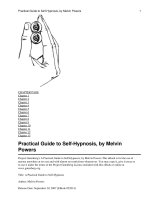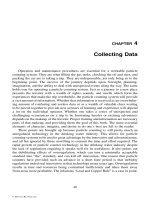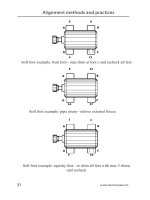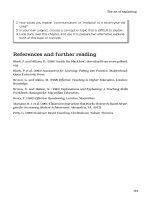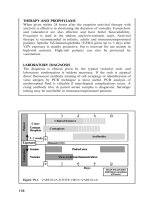Echocardiography A Practical Guide to Reporting - part 4 pdf
Bạn đang xem bản rút gọn của tài liệu. Xem và tải ngay bản đầy đủ của tài liệu tại đây (468.93 KB, 16 trang )
ch04 4/5/07 1:33 pm Page 38
5
VALVE DISEASE
AORTIC STENOSIS
1. Appearance of the valve
• Look at the number of cusps, pattern of thickening and mobility.
These may give a clue to the aetiology (Table 5.1).
2. Assess the LV
• If the LV is hypokinetic, the transaortic pressure difference may
underestimate the grade of the stenosis, and the continuity equation
should be employed.
• Consider dobutamine stress (see Section 6) if there is apparently
moderate aortic stenosis with an impaired LV.
3. Doppler measurements
• Record the continuous waveform using the stand-alone probe from the
apex and at least one other approach (usually suprasternal or right inter-
costal) unless the aortic valve disease is obviously mild as shown by:
– mobile cusps
– low transaortic velocities (V
max
<3.0 m/s)
– a normal LV ejection fraction.
Table 5.1 Clues to the aetiology in aortic stenosis
Systolic Closure Associated features
bowing line
Calcific No Central Calcification of mitral annulus or aorta
degenerative
Bicuspid Yes Eccentric Ascending aortic dilatation, coarctation
Rheumatic Yes Central Mitral involvement
ch05 4/5/07 1:33 pm Page 39
Echocardiography: A Practical Guide for Reporting
40
• If the continuous-wave peak velocity V
max
<3.5 m/s, use the long form
of the Bernoulli equation (Appendix 3.1) for estimating the pressure
difference.
• Use the continuity equation (Appendix 3.2) to calculate the effective
orifice area (EOA) – ideally in all cases, but especially if:
– continuous-wave Doppler suggests moderate aortic stenosis (V
max
=
3–4 m/s), since the EOA may change the grade of stenosis
– the LV is hypokinetic.
4. Assess severity
• If the aortic valve is thickened with V
max
<2.5 m/s (with normal LV
systolic function), report ‘aortic valve thickening with no stenosis’. If
V
max
≥2.5, grade as in Table 5.2.
• Base the assessment on all available observations
• Moderate stenosis must be interpreted carefully:
– An area 1.0–1.5 cm
2
is moderate and <1.0 cm
2
severe by American crite-
ria.
2
– The significance of the EOA depends partly on body size. An EOA
<0.6 cm
2
/m
2
is a threshold for severe stenosis, allowing for body
surface area
– Ultimately, management depends on clinical factors more than on
the exact EOA.
5. General
• Grade aortic regurgitation (page 46).
• Assess the other valves. Functional mitral regurgitation may develop
in severe aortic stenosis as the LV starts to dilate. Mitral surgery is
likely to be necessary if the mitral valve is anatomically abnormal
(e.g., prolapsing) or the regurgitation is more than moderate.
Table 5.2 Severity in aortic stenosis
Mild Moderate Severe
V
max
(m/s) 2.5–3.0 3.0–4.0 >4.0
Peak gradient (mmHg) <40 40–65 >65
Mean gradient (mmHg) <25 25–40 >40
EOA (continuity equation) (cm
2
)
1
>1.2 0.8–1.2 <0.8
ch05 4/5/07 1:33 pm Page 40
• Assess the aorta (page 79). Aortic root dilatation and coarctation are
associated with a bicuspid aortic valve.
• Estimate the PA pressure. Pulmonary hypertension is an indicator of
a poor prognosis in severe aortic stenosis.
• If there is a discrepancy in the pressure difference and the appearance
of the valve, check for a subaortic membrane.
6. Low-flow aortic stenosis
• This is defined as:
– EOA <1 cm
2
, and
– mean gradient <30 mmHg, and
– LV ejection fraction <40%.
• The EOA may be lower than expected for the grade of stenosis as a result
of the LV being unable to generate enough energy to open the valve.
• These patients need dobutamine stress echocardiography. This
requires medical supervision because of the risk of cardiac arrhyth-
mia, although this risk is not great at low infusion rates.
– Give 5 then 10 µg/kg/min dobutamine (occasionally 20 µg/kg/min,
especially if there has been prior beta-blockade).
– Stop the infusion if the subaortic velocity time integral rises >20%
or the heart rate increases.
– Judge the severity of aortic stenosis and whether there is LV
contractile reserve (Table 5.3).
Valve disease
41
Table 5.3 Stress echocardiography in low-flow aortic stenosis
3–5
Is there severe aortic stenosis?
Mean gradient >30 mmHg and EOA <1.2 cm
2
at any time during the
infusion
Is there LV contractile reserve?
Subaortic velocity time integral (or ejection fraction) rises by >20%
Checklist for reporting aortic stenosis
1. Appearance and movement of the aortic valve
2. Grade of stenosis
3. Grade of associated regurgitation
4. Size of aorta and check for coarctation
5. LV dimensions and systolic function
6. Other valves
7. Right ventricular function, including PA pressure
ch05 4/5/07 1:33 pm Page 41
AORTIC REGURGITATION
1. Appearance of the valve and aortic root
• This may allow determination of the aetiology (Table 5.4).
• Measure the aorta at every standard level (see page 81).
2. Colour flow mapping
• Measure the jet height 0.5–1.0 cm below the cusps (on 2D or colour
M-mode) (Figure 5.1) and express as a percentage of the diameter of
the LV outflow tract.
• If the jet is eccentric, the width must be taken perpendicular to its
axis. If it is so eccentric that it impinges on the septum or anterior
mitral leaflet, the method is unreliable.
• The width of the narrowest portion of the jet (the vena contracta) is
a reasonable alternative measurement (see Table 5.5 and Figure 5.1).
3. Continuous-wave signal
• Record either from the apex or, if the jet is directed posteriorly, from
the parasternal position.
• Measure the pressure half-time and note the density of the signal
compared with the density of forward flow.
4. The left ventricle
• Is the LV hyperdynamic (suggesting severe aortic regurgitation)?
Chronic severe regurgitation usually causes LV diastolic dilatation. In
acute regurgitation, the LV diastolic volume may be normal.
• What is the fractional shortening? If it is <25%, this suggests a
relatively poor outcome.
• An LV systolic diameter >5 cm or 2.5 cm/m
2
is an indication for
surgery, even in the absence of symptoms.
6,7
5. Flow reversal at the arch
• From the suprasternal notch, describe:
– whether flow reversal is holodiastolic, fills approximately half of
diastole or is only seen at the start of diastole using colour M-mode
(Figure 5.2) or pulsed Doppler (Figure 5.3)
– how far down the aorta can flow reversal be detected on colour
mapping
Echocardiography: A Practical Guide for Reporting
42
ch05 4/5/07 1:33 pm Page 42
Valve disease
43
Table 5.4 Aetiology of aortic regurgitation
Ascending aortic dilatation • Arteriosclerosis, Marfan syndrome,
dissection
Valve • Bicuspid Rheumatic Calcific degenerative
• Endocarditis Prolapse Trauma
• Rare e.g. systemic lupus erythematosus,
Behçet syndrome, ankylosing spondylitis
Figure 5.1 Regurgitant jet. Parasternal long-axis view. The position for measuring
the height of the colour flow map as a percentage of the outflow tract height is at
(a). The vena contracta or neck is at (b)
a
a
b
b
ch05 4/5/07 1:33 pm Page 43
Echocardiography: A Practical Guide for Reporting
44
Figure 5.2 Flow reversal on colour mapping in the upper descending thoracic
aorta. (a) Using suprasternal colour M-mode in a patient with mild regurgitation
there is localised and short-lived flow reversal. (b) In severe regurgitation, flow
reversal is holodiastolic across the whole aortic lumen and is seen well down the
descending thoracic aorta
(a)
(b)
ch05 4/5/07 1:33 pm Page 44
Valve disease
45
Figure 5.3 Flow reversal on pulsed Doppler in the distal arch. Using a
suprasternal position. Mild regurgitation can be seen to cause short-lived low-velocity
reversal (a), while in severe regurgitation the reversal is holodiastolic with a relatively
high velocity at the end of diastole (e.g. ≥0.2 m/s) (b)
12
(a)
(b)
ch05 4/5/07 1:33 pm Page 45
Echocardiography: A Practical Guide for Reporting
46
Table 5.5 Criteria of severity in aortic regurgitation
2,8–12
Mild Moderate Severe
Colour/LV outflow <25 25–64 ≥65
tract height (%)
Vena contracta <3 3–6 >6
width (mm)
Flow reversal in None Not Holodiastolic
descending aorta holodiastolic
Continuous-wave Faint or Intermediate Dense as
signal intensity incomplete forward flow
waveform
6. Grade the severity of regurgitation
• Make an assessment based on all modalities. The height of the colour
jet in the LV outflow tract and flow reversal beyond the arch are the
most reliable modalities (Table 5.5).
• Also take into account LV size and activity.
• The pressure half-time depends on LV diastolic function and systemic
vascular resistance as well as the severity of aortic regurgitation. A
cut-off of 300 ms is sensitive for severe regurgitation, but will include
some patients with moderate regurgitation.
6. Assess the other valves
• Functional mitral regurgitation may occur secondary to LV dilatation.
MITRAL STENOSIS
1. Appearance of the valve
• Distribution and degree of thickening of both leaflets.
Checklist for reporting aortic regurgitation
1. Appearance of aortic valve
2. Grade of regurgitation
3. Aortic dimensions
4. LV dimensions and systolic function
5. Mitral valve function
ch05 4/5/07 1:33 pm Page 46
• Is there heavy echogenicity in the line of fusion of each commissure?
• Mobility of the leaflets.
• Degree of chordal involvement.
2. Planimeter the orifice area (Figure 5.4)
• Make sure that the section is not oblique.
• Use colour Doppler as a guide to the extent of the orifice if this is
not obvious on imaging.
• Take care not to include the chordae, which if thickened can mimic
the orifice.
• If there is significant reverberation artefact, the measurement may be
inaccurate and should not be made.
3. Continuous wave signal
• Measure the pressure half-time and mean gradient, averaging 3–5
cycles if there is atrial fibrillation.
• The Hatle formula (orifice area = 220/pressure half-time) is an
approximate guide to severity in moderate or severe stenosis.
Valve disease
47
Figure 5.4 Planimetry of the mitral orifice. The orifice is imaged in a parasternal
short-axis view. Care must be taken to section the tips of the mitral leaflets
perpendicularly. A common mistake is to section towards the base of the leaflets or
across thickened chordae
ch05 4/5/07 1:33 pm Page 47
4. Estimate PA pressure (page 94)
• This has a loose relationship with the severity of mitral stenosis, but
pulmonary hypertension is a criterion for surgery or balloon valvotomy:
13
– PA systolic pressure >50 mmHg at rest.
– PA systolic pressure >60 mmHg after exercise.
5. Assess mitral regurgitation (page 52)
• Anything more than mild means that the valve is not suitable for
valvotomy.
6. Assess severity of mitral stenosis (Table 5.6)
• The planimetered orifice area is the only flow-independent measure:
– The pressure half-time will be shortened disproportionate to the
orifice area if there is severe mitral or aortic regurgitation.
– The mean gradient will increase with mitral regurgitation.
7. Assess the other valves
• Tricuspid rheumatic involvement is common, but easily missed.
• Significant aortic valve disease suggests that double valve replacement
rather than balloon mitral valvotomy is indicated.
8. Assess RV function
• A dilated RV is an indication for surgery or balloon valvotomy, even
if there is relatively minor breathlessness.
Echocardiography: A Practical Guide for Reporting
48
Table 5.6 Criteria of severity in mitral stenosis
Mild Moderate Severe
Orifice area by planimetry (cm
2
) >1.5 1.0–1.5 <1.0
Pressure half-time (ms) <150 150–220 >220
Mean gradient (mmHg) <5 5–10 >10
a
PA pressure (mmHg)
b
<30 30–50 >50
a
>15 mmHg after exercise
b
The relationship with valvar stenosis is not tight
ch05 4/5/07 1:33 pm Page 48
9. Is there intra-atrial thrombus?
• TTE is insensitive for detecting thrombus. A TOE should always be
performed before balloon valvotomy.
• A dilated LA >5.5 cm is used as a criterion for warfarin in the
presence of sinus rhythm despite severe mitral stenosis.
13
10. Is the valve suitable for balloon valvotomy?
• The most reliable characteristics of the valve for predicting success
without developing severe mitral regurgitation are given in Table
5.7.
14,15
Some centres use the Wilkins system of scoring 1–4 for valve
mobility, thickening, calcification, and subvalvar involvement (Table
5.8). A total score ≤8 suggests a successful result.
16
MITRAL REGURGITATION
1. Appearance and movement of the valve (Table 5.9)
• Is there thickening of the leaflet? Thickening primarily involves the
tips in rheumatic disease, but is more generalised in antiphospholipid
syndrome or late after radiation. A floppy valve has generalised thick-
ening that is often more obvious in one part of the cycle than another
and is often associated with lax chordae
Valve disease
49
Table 5.7 Markers of successful balloon valvotomy
• Good mobility of the anterior leaflet
• Minor chordal involvement (contrast Figure 5.5)
• No more than mild mitral regurgitation
• No commissural calcification (contrast Figure 5.5)
• No left atrial thrombus (on TOE)
Checklist for reporting mitral stenosis
1. Appearance of valve
2. Severity of stenosis and regurgitation
3. Right-sided pressures and RV function
4. Other valves
5. Is the valve suitable for balloon valvotomy?
ch05 4/5/07 1:33 pm Page 49
Echocardiography: A Practical Guide for Reporting
50
Table 5.8 Wilkins score
Morphology Score
Mobility
Highly mobile, only tips restricted 1
Normal mobility of base and mid-leaflet 2
Valve moves forward in diastole mainly from the base 3
No or minimal movement 4
Leaflet thickening
Near-normal 1
Thickening mainly at tips 2
Thickening (5–8 mm) over the whole leaflet 3
Severe thickening (>8 mm) of whole leaflet 4
Subvalvar thickening
Minimal just below leaflets 1
Over one-third the chordae 2
Extending to the distal third of the chordae 3
Extensive thickening and shortening of the whole chord 4
Calcification
A single area of echogenicity 1
Scattered areas at leaflet margin 2
Echogenicity extending to midportion of leaflets 3
Extensive echogenicity over whole leaflet 4
• Is there evidence of prolapse (Table 5.10) and which parts of the
leaflets are involved (Figure 5.6)? Is the prolapse minor, moderate (like
a bucket handle), or severe (associated with a flail tip and sometimes
a visible ruptured chord)?
• Does the valve open normally during diastole, or is there bowing of
the leaflets suggesting rheumatic disease?
• Is there restriction of motion of the leaflets during systole? (Table
5.11). If so, then look for LV inferoposterior infarction or global LV
systolic dysfunction.
• Is there a discrete echogenic mass (e.g. vegetation or ruptured chord)?
ch05 4/5/07 1:33 pm Page 50
Valve disease
51
Figure 5.5 Commissural calcification and chordal involvement. This is a parasternal
long-axis view angled towards the right to show the medial commissure, which
contains dense calcification. The chordae are heavily matted, and it is difficult to see
the junction with the papillary muscles or the mitral leaflets
Table 5.9 Aetiology of mitral regurgitation
Functional
• Global LV dilatation causing restriction of both mitral leaflets
• Regional inferoposterior wall motion abnormality causing restriction of
the posterior leaflet
Ischaemic
• Acute papillary muscle or occasionally chordal rupture
Organic (abnormal mitral valve)
• Floppy mitral valve
• Endocarditis
• Rheumatic
• Other (e.g. systemic lupus erythematosus, congenital)
ch05 4/5/07 1:33 pm Page 51
Echocardiography: A Practical Guide for Reporting
52
Table 5.10 Signs of prolapse
Prolapse is defined by either:
• movement of part of either leaflet behind the plane of the annulus in
any view other than the 4-chamber view (Figure 5.7a), or
• displacement of the point of coaption behind the plane of the annulus in
the 4-chamber view
Prolapse is associated with
• annular dilatation, leaflet thickening or elongation
• regurgitation, usually directed away from the prolapsing leaflet (Figure
5.7b)
Table 5.11 Restricted leaflet motion
Both leaflets
• Tenting (point of apposition above the plane of the annulus in the 4-
chamber view)
• Centrally directed jet of regurgitation (Figure 5.8)
• Dilated LV, causing abnormal papillary muscle function
Restriction of posterior leaflet motion
• Tip of leaflet held in LV during systole (best seen in a long-axis view)
(Figure 5.9a)
• Jet directed posteriorly (Figure 5.9b)
• Inferior or posterior infarct
Table 5.12 Grading mitral regurgitation
Mild Moderate Severe
Neck width (mm) <3 3–6.9 ≥7
Flow convergence zone Absent Moderate Large
EROA (mm
2
) <20 20–40 >40
Regurgitant volume (ml) <30 30–60 >60
EROA, effective regurgitant orifice area using the PISA method
ch05 4/5/07 1:33 pm Page 52
2. Colour flow mapping
Describe:
• The origin of the jet (e.g., medial, central or lateral part of the orifice).
• The direction of the jet:
– away from a prolapsing leaflet (Figure 5.7b)
– behind a restricted leaflet (Figure 5.9b)
– centrally if there is symmetric ‘tenting’ of the leaflets (Figure 5.8)
or usually in rheumatic disease.
• The size of the flow recruitment area in the LV by eye or using the
PISA method if this is local policy (Table 5.12).
17
• The width of the narrowest portion (neck or vena contracta) of the
jet close to the level of the valve (Table 5.12).
• The approximate size of the intra-atrial portion of a central jet. This
gives qualitative confirmation of the more accurate flow acceleration
and neck size. Usually this is judged by eye, but in severe regurgita-
tion the jet area is usually >8 cm
2
, while in mild it is usually <4 cm
2
.
18
If the jet hugs the wall of the LA, it will stretch out, and its area is
then a particularly poor guide to severity.
Valve disease
53
A
1
A
2
A
3
P
3
Septal
P
2
P
1
R
N
Mitral
Pulmonary
Aortic
R
R
L
L
A
N
Anterior
Posterolateral
Tricuspid
A
2
P
2
P
1
A
3/2
S
A
A
2
P
3
P
1
P
3
A
2
A
1
Figure 5.6 Mitral valve segments on TTE. This scheme includes a view through
the commissures adapted from TOE. This can often be obtained transthoracically by
slight angulation and rotation from the apical 2-chamber view
ch05 4/5/07 1:33 pm Page 53
